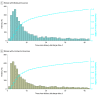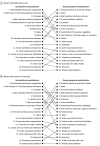Assessment of Incidence and Factors Associated With Severe Maternal Morbidity After Delivery Discharge Among Women in the US
- PMID: 33528553
- PMCID: PMC7856547
- DOI: 10.1001/jamanetworkopen.2020.36148
Assessment of Incidence and Factors Associated With Severe Maternal Morbidity After Delivery Discharge Among Women in the US
Erratum in
-
Error in Abstract Conclusions and Relevance.JAMA Netw Open. 2021 Mar 1;4(3):e213451. doi: 10.1001/jamanetworkopen.2021.3451. JAMA Netw Open. 2021. PMID: 33656525 Free PMC article. No abstract available.
Abstract
Importance: Previous efforts to examine severe maternal morbidity (SMM) in the US have focused on delivery hospitalizations. Little is known about de novo SMM that occurs after delivery discharge.
Objective: To investigate the incidence, timing, factors, and maternal characteristics associated with de novo SMM after delivery discharge among women in the US.
Design, setting, and participants: In this retrospective cohort study, data from the IBM MarketScan Multi-State Medicaid database and the IBM MarketScan Commercial Claims and Encounters database were used to construct a sample of women aged 15 to 44 years who delivered between January 1, 2010, and September 30, 2014. Severe maternal morbidity was reported by the timing of diagnosis, and the associated maternal characteristics were examined. Women in the Medicaid and commercial insurance sample were classified into 3 distinct outcome groups: (1) those without any SMM during the delivery hospitalization and the postdelivery period (reference group), (2) those who exhibited at least 1 factor associated with SMM during the delivery hospitalization, and (3) those who exhibited any factor associated with de novo SMM after delivery discharge (defined as SMM that was first diagnosed in the inpatient setting during the 6 weeks [or 42 days] after discharge from the delivery hospitalization, conditional on no factor associated with SMM being identified during delivery). Data were analyzed from February to July 2020.
Exposures: Timing of SMM diagnosis.
Main outcomes and measures: Women with SMM were identified using diagnosis and procedure codes from the International Classification of Diseases, Ninth Revision, Clinical Modification for the 21 factors associated with SMM that were developed by the Centers for Disease Control and Prevention.
Results: A total of 2 667 325 women in the US with delivery hospitalizations between 2010 and 2014 were identified; of those, 809 377 women (30.3%) had Medicaid insurance (30.3%; mean [SD] age, 25.6 [5.5] years; 51.1% White), and 1 857 948 women (69.7%; mean [SD] age, 30.6 [5.4] years; 36.4% from the southern region of the US) had commercial insurance. Among those with Medicaid insurance, 17 584 women (2.2%) experienced SMM during the delivery hospitalization, and 3265 women (0.4%) experienced de novo SMM after delivery discharge. Among those with commercial insurance, 32 079 women (1.7%) experienced SMM during the delivery hospitalization, and 5275 women (0.3%) experienced de novo SMM after hospital discharge. A total of 5275 SMM cases (14.1%) and 3265 SMM cases (15.7%) among women with commercial and Medicaid insurance, respectively, developed de novo within 6 weeks after hospital discharge; of those, 3993 cases (75.7%) in the commercial insurance cohort and 2399 cases (73.5%) in the Medicaid cohort were identified in the first 2 weeks after discharge. The most common factors associated with SMM varied based on the timing of diagnosis. In the Medicaid population, non-Hispanic Black women (adjusted odds ratio [aOR], 1.53; 95% CI, 1.48-1.58), Hispanic women (aOR, 1.46; 95% CI, 1.37-1.57), and women of other races or ethnicities (aOR, 1.40; 95% CI, 1.33-1.47) had higher rates of SMM during delivery hospitalization than non-Hispanic White women; however, only the disparity between Black and White women (aOR, 1.69; 95% CI, 1.57-1.81) persisted into the postdischarge period.
Conclusions and relevance: In this study, 15.7% of SMM cases in the Medicaid cohort and 14.1% of SMM cases in the commercial insurance cohort first occurred after the delivery hospitalization, with notable disparities in factors and maternal characteristics associated with the development of SMM. These findings suggest a need to expand the focus of SMM assessment to the postdelivery discharge period.
Conflict of interest statement
Figures


Comment in
-
Data and a Call for Action to Improve Maternal Health.JAMA Netw Open. 2021 Feb 1;4(2):e2037291. doi: 10.1001/jamanetworkopen.2020.37291. JAMA Netw Open. 2021. PMID: 33528549 No abstract available.
References
-
- Centers for Disease Control and Prevention Pregnancy mortality surveillance system. Centers for Disease Control and Prevention, US Department of Health and Human Services; 2020. Accessed March 4, 2020. https://www.cdc.gov/reproductivehealth/maternal-mortality/pregnancy-mort...
-
- Maternal Mortality Review Committees Report from Maternal Mortality Review Committees: A View into Their Critical Role. Building US Capacity to Review and Prevent Maternal Deaths Program, CDC Foundation; 2017. Accessed March 4, 2020. https://www.cdcfoundation.org/sites/default/files/files/MMRIAReport.pdf
-
- Maternal Mortality Review Committees Report From Nine Maternal Mortality Review Committees. Building US Capacity to Review and Prevent Maternal Deaths Program, CDC Foundation; 2018. Accessed March 4, 2020. https://www.cdcfoundation.org/sites/default/files/files/ReportfromNineMM...
MeSH terms
LinkOut - more resources
Full Text Sources
Other Literature Sources
Medical

